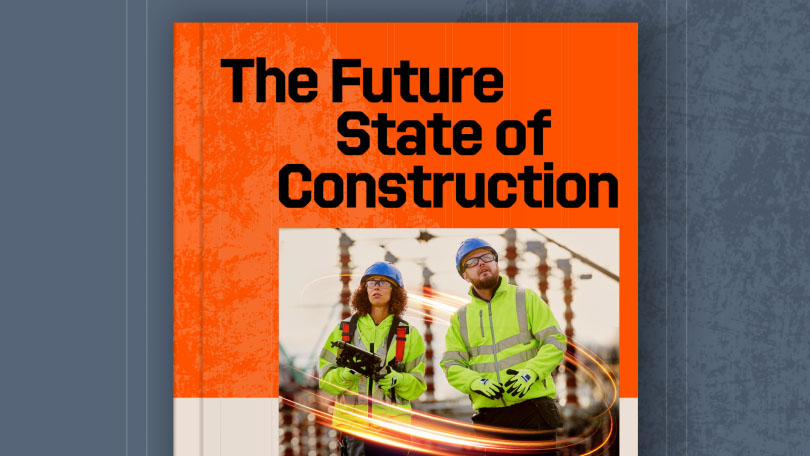— 5 min read
HRB or Not? Decoding Higher-Risk Building Classifications


Last Updated Aug 28, 2025

Brett King
Director of Industry Transformation, EMEA
Brett King is a construction industry transformation leader with over 15 years' experience delivering major projects and driving operational excellence across the UK and EMEA. As Director of Industry Transformation at Procore, he helps clients tackle complex challenges—from regulatory compliance and digital adoption to data strategy, AI integration, and change management at scale. With a background in business improvement and tech implementation at leading contractors, Brett bridges site-level realities with strategic outcomes—translating vision into action. A regular speaker, workshop facilitator, and trusted advisor, he’s known for making the complex simple and the theoretical practical. When he’s not driving change in construction, he’s driving greens, chasing Strava segments, or finding the best thing on the menu.

Anna K. Cottrell
Writer and Editor
Anna K. Cottrell is a writer and researcher with an expertise in the property and finance sectors.

Zoe Mullan
27 articles
Zoe Mullan is an experienced content writer and editor with a background in marketing and communications in the e-learning sector. Zoe holds an MA in English Literature and History from the University of Glasgow and a PGDip in Journalism from the University of Strathclyde and lives in Northern Ireland.
Last Updated Aug 28, 2025

The Building Safety Act of 2022 revolutionised how the construction industry approaches building safety, introducing comprehensive changes to design and enforcement processes. However, this industry-wide transition has created widespread confusion and uncertainty within the construction sector. As a result, too many projects are sleepwalking into non-compliance.
The statistics paint a concerning picture. Since implementing the BSA system, the Building Safety Regulator has approved just 20 Gateway 2 building applications out of 187 submitted – a mere 10% approval rate that's creating brutal bottlenecks, stalling projects, and damaging trust.
Several factors contribute to this worrying statistic. Most notably, construction professionals lack clarity about which projects qualify as higher-risk and the exact processes this designation triggers.
Recent research reveals alarming knowledge gaps among construction professionals:
- 22% struggle to understand which projects fall within the Act's scope
- 40% don't know their responsibilities for higher-risk buildings
- 50% remain unclear about duty holder requirements
Yet the Act demands total clarity and full compliance from day one.
Table of contents
The Deceptive Simplicity of HRB Definitions
At first glance, higher-risk building classifications appear straightforward. Buildings qualify as HRBs when they are:
- At least 18 metres tall OR seven storeys high
- Residential buildings with at least two residential units
The Act clearly excludes buildings comprised "entirely of care homes, hospitals, barracks, secure residential institutions and hotels".
However, this apparent clarity masks a significant level of complexity. The definition doesn't simply focus on height – it encompasses use, layout, amenities, and risk profile. Even mezzanines and basements can tip the balance, transforming a seemingly straightforward project into an HRB without warning.
Residential Use: More Complex Than It Appears
The criteria for classifying buildings as higher-risk fall into two main categories: structural properties and use. Both categories generate confusion, particularly around what constitutes 'residential' use.
The Hotel vs Serviced Apartment Paradox
The hotel exclusion has prompted legal experts to question the precise meaning of 'residential.' The Act defines a 'residential' unit as a "dwelling" or "any other unit of living accommodation." Hotels arguably provide living accommodation – some people live in hotels for extended periods. Yet hotels remain "excluded regardless of how long these buildings are occupied," unlike serviced apartments that fall under higher-risk definitions when housed in buildings seven storeys or 18 metres tall.
Consider a mixed-use development: serviced apartments above, co-working spaces below, and a gym in the basement. Where does this complex arrangement fit within the regulations?
One legal expert poses the question, 'Is the nature of the building, rather than the length of occupancy, the defining factor? Why then does the government include "serviced apartments" within the HRB regime?' The expert suggests that 'the provision of some amenities (such as lounges, kitchens, or wardrobes) may be what divides them.'
Safety Infrastructure as a Determining Factor
Hotels already fall under the Fire Safety Order 2005 and typically maintain robust fire evacuation procedures with 24/7 staffing. Serviced apartments, despite similar usage patterns, lack comparable safety monitoring systems.
Similarly, stadiums receive exclusions from HRB definitions under the BSA. Although stadiums may contain residential quarters for staff, events remain their primary use. Like hotels, stadiums operate under stringent fire safety regulations with emergency staff available around the clock.
These examples suggest that predominant building use, combined with available amenities and emergency staffing arrangements, collectively define residential units.
Common Classification Pitfalls
Construction teams frequently encounter these misconceptions when determining HRB status:
Height and Storey Requirements
The "Both" Misconception
Many assume buildings must meet both criteria – 18 metres tall AND seven storeys. In reality, residential buildings with two or more units qualify when they reach EITHER 18 metres OR seven storeys.
Mixed-Use Counting Errors
Teams often fail to count special-use areas properly. A residential block with six storeys of flats plus a ground-floor shared gym qualifies as an HRB (seven storeys total).
Sloped Site Complications
Terraced properties on slopes present calculation challenges. When a partially below-ground storey has its finished ceiling above ground level, it counts towards the total, potentially triggering HRB classification.
Mezzanine Miscalculations
Mezzanine levels don't automatically add to storey counts, but they do when covering 50% or more of the largest above-ground storey's internal floor area.
The Reality of Guidance Implementation
The official government HRB guidance provides seemingly clear templates for calculating building height and storey counts, complete with examples and exclusions. Nevertheless, project teams will often produce various interpretations, particularly when mixed-use or phased developments enter the equation.
This variability makes proactive validation with local authorities essential rather than optional – it serves as a critical safety net. Project teams must verify their project's status with local authorities before submitting planning applications, even when they believe HRB definitions likely don't apply to their building.
Local Authority Building Control, representing all local authority building control teams in England and Wales, should serve as the first point of contact.
The Cost of Misclassification
What happens when teams discover they have an HRB project without knowing? The cost proves devastating: months or even years lost, scrapped designs and rejected applications. Also, engagement with a regulator already operating on the assumption that most professionals don't understand the requirements yet.
A recent case illustrates these consequences. A developer converted a building into a hotel, but not entirely – the lower floors remained leased as separate units. Although hotels receive HRB exemptions, this building didn't qualify for the exemption as a whole. The local authority rejected the planning permission application, forcing the developer to completely overhaul both the project and application to meet BSR Gateway requirements.
Given the current application backlog, Gateway 2 delays already extend development timeframes by many months. Losing additional time by applying to incorrect regulating authorities, without proper accountable persons in place, and with inadequate documentation, extends the process by several years.
In worst-case scenarios, failing to apply through the Gateway system may constitute non-compliance, triggering BSR scrutiny and enforcement action.
Moving Forward: Treating HRB Risk as Design Parameter
Clarity on HRB classification is essential for timely project completion. Remember that incorrectly assuming projects don't have HRB status sets back Gateway application timelines, also affecting insurance and liability arrangements.
The question shouldn't be 'can we avoid HRB classification?' Instead, project teams should ask: 'Are we absolutely certain we're not at risk of later classification?' Getting this wrong risks more than delays – it threatens non-compliance, legal exposure, and months of rework.
The most successful developers now treat HRB risk as a design parameter rather than an administrative checkbox. This proactive approach ensures projects stay on track while maintaining full regulatory compliance from project inception.
Categories:
Preconstruction, Project Management, Risk Management, Safety and Compliance
Written by

Brett King
Director of Industry Transformation, EMEA | Procore Technologies
Brett King is a construction industry transformation leader with over 15 years' experience delivering major projects and driving operational excellence across the UK and EMEA. As Director of Industry Transformation at Procore, he helps clients tackle complex challenges—from regulatory compliance and digital adoption to data strategy, AI integration, and change management at scale. With a background in business improvement and tech implementation at leading contractors, Brett bridges site-level realities with strategic outcomes—translating vision into action. A regular speaker, workshop facilitator, and trusted advisor, he’s known for making the complex simple and the theoretical practical. When he’s not driving change in construction, he’s driving greens, chasing Strava segments, or finding the best thing on the menu.
View profile
Anna K. Cottrell
Writer and Editor | Freelance
Anna K. Cottrell is a writer and researcher with an expertise in the property and finance sectors.
View profileReviewed by

Zoe Mullan
27 articles
Zoe Mullan is an experienced content writer and editor with a background in marketing and communications in the e-learning sector. Zoe holds an MA in English Literature and History from the University of Glasgow and a PGDip in Journalism from the University of Strathclyde and lives in Northern Ireland.
View profileExplore more helpful resources

Control the Chaos: Standardising Document Workflows in Construction Projects
Document control and implementation play a central role in managing risk, meeting deadlines, and delivering projects to spec. As builds become more complex and teams increasingly disperse, the volume and...

Cost-Plus Construction Contracts in the UK
A construction cost-plus contract – sometimes called a cost-reimbursable or prime cost contract – reimburses all project costs and adds a fee to cover the contractor’s overhead and profit. UK...

Digital Construction Technology for Whole-Life Value
For decades, the construction industry has kept a narrow focus on capital cost — the one-time, upfront costs of a construction project. While in the short term this seems like...

UK Construction Progress Reports: Tools for Smarter Site Management
Construction progress reports track completed work, on site issues, costs, and safety so UK project teams can demonstrate progress, secure payments, and stay on programme. Accurate progress data is essential...
